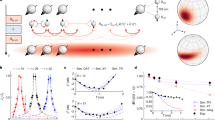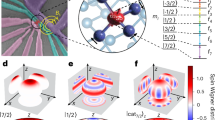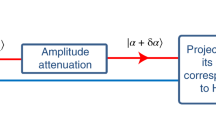Abstract
Quantum metrology with non-classical states offers a promising route to improved precision in physical measurements. The quantum effects of Schrödinger-cat superpositions or entanglements enable measurement uncertainties to reach below the standard quantum limit. However, the challenge of maintaining a long coherence time for such non-classical states often prevents full exploitation of the quantum advantage in metrology. Here we demonstrate a long-lived Schrödinger-cat state of optically trapped 173Yb (I = 5/2) atoms. The cat state, a superposition of two oppositely directed and furthest-apart spin states, is generated by a nonlinear spin rotation. Protected in a decoherence-free subspace against inhomogeneous light shifts of an optical lattice, the cat state persists for a coherence time of 1.4(1) × 103 s. A magnetic field is measured using Ramsey interferometry, demonstrating a scheme of Heisenberg-limited metrology for atomic magnetometry, quantum information processing and searching for new physics beyond the Standard Model.
This is a preview of subscription content, access via your institution
Access options
Access Nature and 54 other Nature Portfolio journals
Get Nature+, our best-value online-access subscription
$32.99 / 30 days
cancel any time
Subscribe to this journal
Receive 12 print issues and online access
$259.00 per year
only $21.58 per issue
Buy this article
- Purchase on SpringerLink
- Instant access to full article PDF
Prices may be subject to local taxes which are calculated during checkout





Similar content being viewed by others
Data availability
Source data for Figs. 2–4 are available via Figshare at https://doi.org/10.6084/m9.figshare.24151038 (ref. 58).
References
Haroche, S. & Raimond, J.-M. Exploring the Quantum: Atoms, Cavities, and Photons (Oxford Univ. Press, 2006); https://doi.org/10.1093/acprof:oso/9780198509141.001.0001
Monroe, C., Meekhof, D. M., King, B. E. & Wineland, D. J. A “Schrödinger cat" superposition state of an atom. Science 272, 1131–1136 (1996).
Facon, A. et al. A sensitive electrometer based on a Rydberg atom in a Schrödinger-cat state. Nature 535, 262–265 (2016).
Chalopin, T. et al. Quantum-enhanced sensing using non-classical spin states of a highly magnetic atom. Nat. Commun. 9, 4955 (2018).
Dietsche, E. K. et al. High-sensitivity magnetometry with a single atom in a superposition of two circular Rydberg states. Nat. Phys. 15, 326–329 (2019).
Bild, M. et al. Schrödinger cat states of a 16-microgram mechanical oscillator. Science 380, 274–278 (2023).
Pezzè, L., Smerzi, A., Oberthaler, M. K., Schmied, R. & Treutlein, P. Quantum metrology with nonclassical states of atomic ensembles. Rev. Mod. Phys. 90, 035005 (2018).
Gross, C., Zibold, T., Nicklas, E., Estève, J. & Oberthaler, M. K. Nonlinear atom interferometer surpasses classical precision limit. Nature 464, 1165–1169 (2010).
Strobel, H. et al. Fisher information and entanglement of non-Gaussian spin states. Science 345, 424–427 (2014).
Hosten, O., Engelsen, N. J., Krishnakumar, R. & Kasevich, M. A. Measurement noise 100 times lower than the quantum-projection limit using entangled atoms. Nature 529, 505–508 (2016).
Bao, H. et al. Spin squeezing of 1011 atoms by prediction and retrodiction measurements. Nature 581, 159–163 (2020).
Pedrozo-Peñafiel, E. et al. Entanglement on an optical atomic-clock transition. Nature 588, 414–418 (2020).
Erhard, M., Krenn, M. & Zeilinger, A. Advances in high-dimensional quantum entanglement. Nat. Rev. Phys. 2, 365–381 (2020).
Liu, Q. et al. Nonlinear interferometry beyond classical limit enabled by cyclic dynamics. Nat. Phys. 18, 167–171 (2022).
Greve, G. P., Luo, C., Wu, B. & Thompson, J. K. Entanglement-enhanced matter-wave interferometry in a high-finesse cavity. Nature 610, 472–477 (2022).
Caves, C. M., Thorne, K. S., Drever, R. W. P., Sandberg, V. D. & Zimmermann, M. On the measurement of a weak classical force coupled to a quantum-mechanical oscillator. I. Issues of principle. Rev. Mod. Phys. 52, 341–392 (1980).
Raimond, J. M., Brune, M. & Haroche, S. Manipulating quantum entanglement with atoms and photons in a cavity. Rev. Mod. Phys. 73, 565–582 (2001).
Zurek, W. H. Decoherence, einselection, and the quantum origins of the classical. Rev. Mod. Phys. 75, 715–775 (2003).
Fröwis, F., Sekatski, P., Dür, W., Gisin, N. & Sangouard, N. Macroscopic quantum states: measures, fragility, and implementations. Rev. Mod. Phys. 90, 025004 (2018).
Walther, P. et al. De Broglie wavelength of a non-local four-photon state. Nature 429, 158–161 (2004).
Mitchell, M. W., Lundeen, J. S. & Steinberg, A. M. Super-resolving phase measurements with a multiphoton entangled state. Nature 429, 161–164 (2004).
Hald, J., Sørensen, J. L., Schori, C. & Polzik, E. S. Spin squeezed atoms: a macroscopic entangled ensemble created by light. Phys. Rev. Lett. 83, 1319–1322 (1999).
Orzel, C., Tuchman, A. K., Fenselau, M. L., Yasuda, M. & Kasevich, M. A. Squeezed states in a Bose–Einstein condensate. Science 291, 2386–2389 (2001).
Zurek, W. Decoherence and the transition from quantum to classical. Phys. Today 44, 36–44 (1991).
Myatt, C. J. et al. Decoherence of quantum superpositions through coupling to engineered reservoirs. Nature 403, 269–273 (2000).
Deléglise, S. et al. Reconstruction of non-classical cavity field states with snapshots of their decoherence. Nature 455, 510–514 (2008).
Lidar, D. A., Chuang, I. L. & Whaley, K. B. Decoherence-free subspaces for quantum computation. Phys. Rev. Lett. 81, 2594–2597 (1998).
Haroche, S. Nobel Lecture: Controlling photons in a box and exploring the quantum to classical boundary. Rev. Mod. Phys. 85, 1083–1102 (2013).
Wang, Y. et al. Single-qubit quantum memory exceeding ten-minute coherence time. Nat. Photonics 11, 646–650 (2017).
Wang, P. et al. Single ion qubit with estimated coherence time exceeding one hour. Nat. Commun. 12, 233 (2021).
Lidar, D.A. in Quantum Information and Computation for Chemistry (ed. Kais, S.) 295–354 (Wiley, 2014); https://doi.org/10.1002/9781118742631.ch11
Kielpinski, D. et al. A decoherence-free quantum memory using trapped ions. Science 291, 1013–1015 (2001).
Roos, C. F., Chwalla, M., Kim, K., Riebe, M. & Blatt, R. ‘Designer atoms’ for quantum metrology. Nature 443, 316–319 (2006).
Safronova, M. S. et al. Search for new physics with atoms and molecules. Rev. Mod. Phys. 90, 025008 (2018).
Chupp, T. E., Fierlinger, P., Ramsey-Musolf, M. J. & Singh, J. T. Electric dipole moments of the atoms, molecules, nuclei and particles. Rev. Mod. Phys. 91, 015001 (2019).
Jenkins, A., Lis, J. W., Senoo, A., McGrew, W. F. & Kaufman, A. M. Ytterbium nuclear-spin qubits in an optical tweezer array. Phys. Rev. X 12, 021027 (2021).
Ma, S. et al. Universal gate operations on nuclear spin qubits in an optical tweezer array of 171Yb atoms. Phys. Rev. X 12, 021028 (2022).
Huie, W. et al. Repetitive readout and real-time control of nuclear spin qubits in 171Yb atoms. Phys. Rev. X Quantum 4, 030337 (2023).
Arecchi, F. T., Courtens, E., Gilmore, R. & Thomas, H. Atomic coherent states in quantum optics. Phys. Rev. A 6, 2211–2237 (1972).
Kwon, H., Tan, K. C., Volkoff, T. & Jeong, H. Nonclassicality as a quantifiable resource for quantum metrology. Phys. Rev. Lett. 122, 040503 (2019).
Dowling, J. P., Agarwal, G. S. & Schleich, W. P. Wigner distribution of a general angular-momentum state: applications to a collection of two-level atoms. Phys. Rev. A 49, 4101–4109 (1994).
Zheng, T. A. et al. Magic wavelengths of the Yb (6s2 1S0–6s6p 3P1) intercombination transition. Phys. Rev. A 102, 062805 (2020).
Yurke, B. & Stoler, D. Generating quantum mechanical superpositions of macroscopically distinguishable states via amplitude dispersion. Phys. Rev. Lett. 57, 13–16 (1986).
Sanders, B. C. Quantum dynamics of the nonlinear rotator and the effects of continual spin measurement. Phys. Rev. A 40, 2417–2427 (1989).
Smith, G. A., Chaudhury, S., Silberfarb, A., Deutsch, I. H. & Jessen, P. S. Continuous weak measurement and nonlinear dynamics in a cold spin ensemble. Phys. Rev. Lett. 93, 163602 (2004).
Zheng, T. A. et al. Measurement of the electric dipole moment of 171Yb atoms in an optical dipole trap. Phys. Rev. Lett. 129, 083001 (2022).
Ye, J., Kimble, H. J. & Katori, H. Quantum state engineering and precision metrology using state-insensitive light traps. Science 320, 1734–1738 (2008).
Neyenhuis, B. et al. Anisotropic polarizability of ultracold polar 40K87Rb molecules. Phys. Rev. Lett. 109, 230403 (2012).
Ramsey, N. F. A molecular beam resonance method with separated oscillating fields. Phys. Rev. 78, 695–699 (1950).
McConnell, R., Zhang, H., Hu, J., Ćuk, S. & Vuletić, V. Entanglement with negative Wigner function of almost 3,000 atoms heralded by one photon. Nature 519, 439–442 (2015).
Ringbauer, M. et al. A universal qudit quantum processor with trapped ions. Nat. Phys. 18, 1053–1057 (2021).
Rosenbusch, P. et al. ac Stark shift of the Cs microwave atomic clock transitions. Phys. Rev. A 79, 013404 (2009).
Le Kien, F., Schneeweiss, P. & Rauschenbeutel, A. Dynamical polarizability of atoms in arbitrary light fields: general theory and application to cesium. Eur. Phys. J. D 67, 92 (2013).
Stone, N. J. Table of nuclear magnetic dipole and electric quadrupole moments. At. Data Nucl. Data Tables 90, 75–176 (2005).
Chen, S. Ultra-low noise magnetic field for quantum gases. Rev. Sci. Instrum. 90, 054708 (2019).
Schmied, R. & Treutlein, P. Tomographic reconstruction of the Wigner function on the Bloch sphere. New J. Phys. 13, 065019 (2011).
Everett, J. E. & Osemeikhian, J. E. Spherical coils for uniform magnetic fields. J. Sci. Instrum. 43, 470–474 (1966).
Yang, Y. et al. Minutes-scale Schrödinger-cat state of spin-5/2 atoms. Figshare https://doi.org/10.6084/m9.figshare.24151038 (2024).
Acknowledgements
We thank D. Sheng and M. Krstají for fruitful discussions, M.-D. Li and W.-K. Hu for contribution to the apparatus during the early stages. This work is supported by the National Natural Science Foundation of China (NSFC) through grant no. 12174371 and the Innovation Program for Quantum Science and Technology through grant no. 2021ZD0303100. C.-L.Z. was supported by the NSFC through grant no. 11922411 and by the Innovation Program for Quantum Science and Technology through grant no. 2021ZD0300203.
Author information
Authors and Affiliations
Contributions
Y.A.Y., W.-T.L. and J.-L.Z. constructed the experimental apparatus and performed the experiments and simulations. C.-L.Z. made contributions to the theory part. Y.A.Y., W.-T.L., J.-L.Z., S.-Z.W., C.-L.Z., T.X. and Z.-T.L. carried out data analysis and wrote the manuscript.
Corresponding authors
Ethics declarations
Competing interests
The authors declare no competing interests.
Peer review
Peer review information
Nature Photonics thanks Adam Miranowicz and the other, anonymous, reviewer(s) for their contribution to the peer review of this work.
Additional information
Publisher’s note Springer Nature remains neutral with regard to jurisdictional claims in published maps and institutional affiliations.
Extended data
Extended Data Fig. 1 Polarizabilities and effective Rabi frequencies.
a, the dynamical vector and tensor polarizabilities \({\alpha }_{F}^{\{{\rm{V}},{\rm{T}}\}}\) of 1S0 are plotted as a function of the laser frequency, whose value is relative to the \(6{{\rm{s}}{}^{2}}^{1}{{\rm{S}}}_{0}\to 6{\rm{s}}6{{\rm{p}}}^{3}{{\rm{P}}}_{1},F=5/2\to F=3/2\) hyperfine transition. For polarizabilities 1a. u. = 1.648773 × 10−41 C m2 V−1. b, The generalized Rabi frequencies \({\Omega }_{x}^{(1)}\) and \({\Omega }_{x,x}^{(2)}\) are plotted as a function of the laser frequency, where \({\Omega }_{x}^{(1)}=-\frac{{\alpha }_{F}^{V}}{8F}{| {\mathcal{E}}| }^{2}\) and \({\Omega }_{x,x}^{(2)}=\frac{3{\alpha }_{F}^{T}}{8F(2F-1)}{| {\mathcal{E}}| }^{2}\). The Rabi frequencies are normalized assuming a light intensity I of = 1W/cm2, and \({| {\mathcal{E}}| }^{2}=\frac{2I}{{\epsilon }_{0}c}\). The inset shows the frequency ratio \(| {\Omega }_{x}^{(1)}/{\Omega }_{x,x}^{(2)}|\).
Extended Data Fig. 2 Principal of state-selective measurement.
The tensor light shift induced by the trap laser distinctly separates Zeeman sublevels of the upper state 3P1, effectively preventing photon absorption by the \(\left\vert -5/2\right\rangle\) state. Following the measurement of the population of the \(\left\vert +5/2\right\rangle\) state, a π pulse generated by the control laser swaps the populations of the \(\left\vert +5/2\right\rangle\) and \(\left\vert -5/2\right\rangle\) states. Subsequently, the same probe pulse is applied to detect the population of the original \(\left\vert -5/2\right\rangle\) state.
Rights and permissions
Springer Nature or its licensor (e.g. a society or other partner) holds exclusive rights to this article under a publishing agreement with the author(s) or other rightsholder(s); author self-archiving of the accepted manuscript version of this article is solely governed by the terms of such publishing agreement and applicable law.
About this article
Cite this article
Yang, Y.A., Luo, WT., Zhang, JL. et al. Minute-scale Schrödinger-cat state of spin-5/2 atoms. Nat. Photon. 19, 89–94 (2025). https://doi.org/10.1038/s41566-024-01555-3
Received:
Accepted:
Published:
Issue date:
DOI: https://doi.org/10.1038/s41566-024-01555-3



